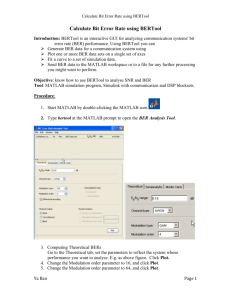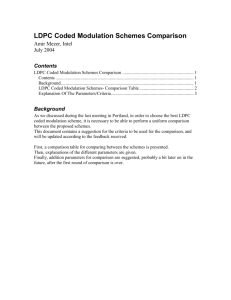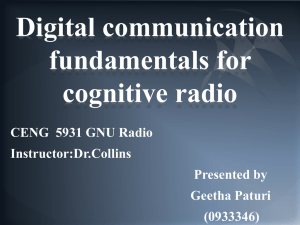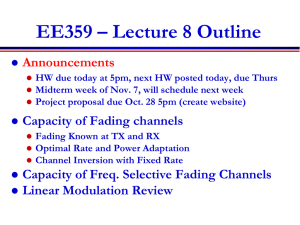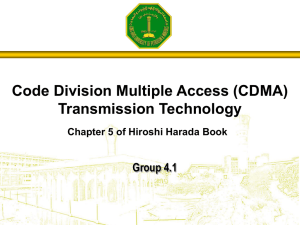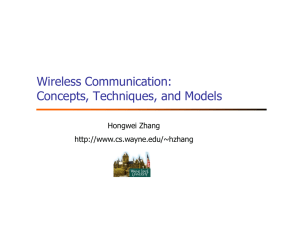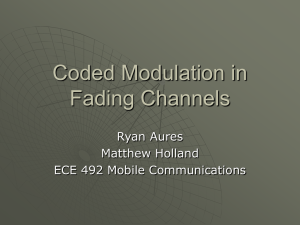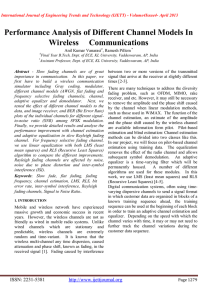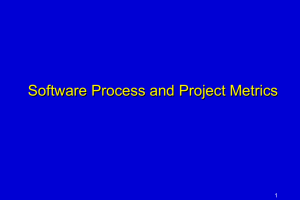Modulation and Detection - Table of Contents
advertisement
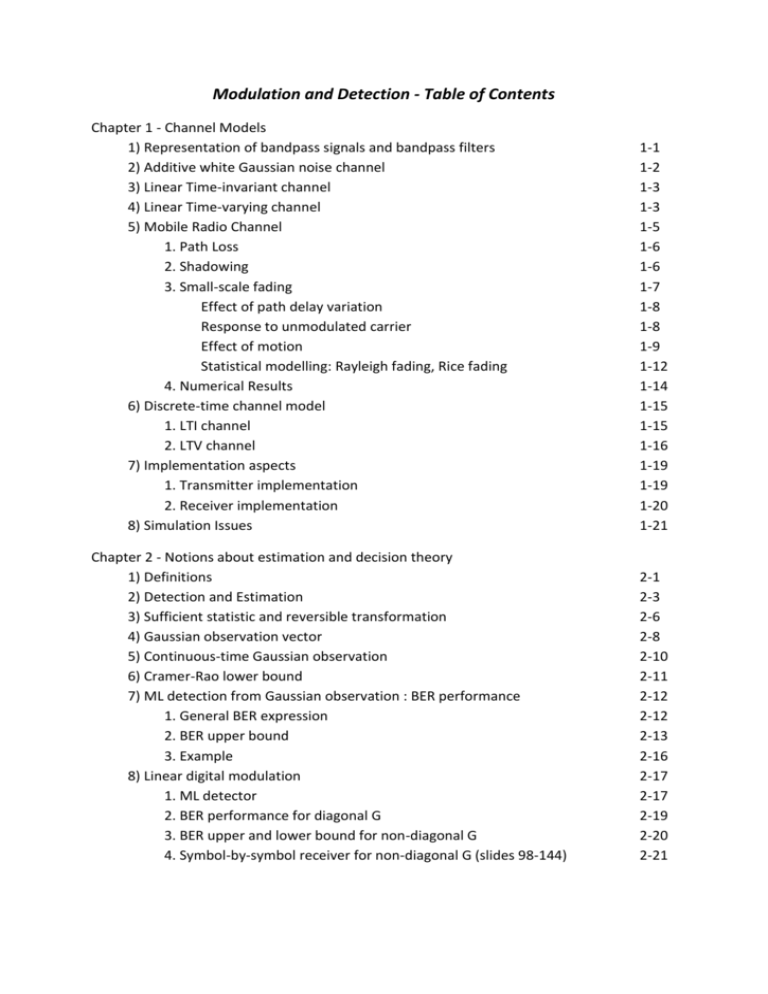
Modulation and Detection - Table of Contents Chapter 1 - Channel Models 1) Representation of bandpass signals and bandpass filters 2) Additive white Gaussian noise channel 3) Linear Time-invariant channel 4) Linear Time-varying channel 5) Mobile Radio Channel 1. Path Loss 2. Shadowing 3. Small-scale fading Effect of path delay variation Response to unmodulated carrier Effect of motion Statistical modelling: Rayleigh fading, Rice fading 4. Numerical Results 6) Discrete-time channel model 1. LTI channel 2. LTV channel 7) Implementation aspects 1. Transmitter implementation 2. Receiver implementation 8) Simulation Issues 1-1 1-2 1-3 1-3 1-5 1-6 1-6 1-7 1-8 1-8 1-9 1-12 1-14 1-15 1-15 1-16 1-19 1-19 1-20 1-21 Chapter 2 - Notions about estimation and decision theory 1) Definitions 2) Detection and Estimation 3) Sufficient statistic and reversible transformation 4) Gaussian observation vector 5) Continuous-time Gaussian observation 6) Cramer-Rao lower bound 7) ML detection from Gaussian observation : BER performance 1. General BER expression 2. BER upper bound 3. Example 8) Linear digital modulation 1. ML detector 2. BER performance for diagonal G 3. BER upper and lower bound for non-diagonal G 4. Symbol-by-symbol receiver for non-diagonal G (slides 98-144) 2-1 2-3 2-6 2-8 2-10 2-11 2-12 2-12 2-13 2-16 2-17 2-17 2-19 2-20 2-21 Chapter 3 - Digital Transmission over the AWGN channel 1) Transmitter and channel description 2) ML Receiver 3) BER performance 4) How to achieve Gtot = IN? 1. Conventional linear digital modulation 2. Block transform linear digital modulation 5) Requirement on available channel bandwidth 3-1 3-4 3-6 3-9 3-9 3-10 3-12 Chapter 4 - Diversity transmission over parallel frequency-flat time-flat fading channels 1) Transmitter and channel description 4-1 2) ML Receiver 4-2 3) BER performance 4-4 1. AWGN channels 4-4 2. Rayleigh fading channels 4-5 4) Practical realizations of diversity transmission 4-9 1. Frequency diversity 4-9 2. Time diversity 4-9 3. Antenna diversity (spatial diversity) 4-11 5) Remarks 4-13 1. Rice fading 4-13 2. Correlated Rayleigh fading 4-13 3. Use of error-correcting codes 4-14 6) Appendix: BER computation 4-15 1. Upper bound on Q(x) 4-15 2. Computation of E[exp(-(Eb/N0)αd|Hch,d(i)|²] 4-15 Chapter 5 - Multiuser communication on the AWGN channel 1) Definitions and terminology 2) Multiuser system description 3) ML detection for orthogonal user signals 4) Basic duplexing, multiplexing and multiple access schemes 5) Description of the Base Station and the User Terminal 6) Requirements on signal coordination 7) Peak power considerations 8) Accommodating variable symbol rates 9) The effect of channel dispersion 10) The cellular radio concept 11) Upstream power control 12) Downstream power control 13) Cell sizes 14) A few current standards 5-1 5-2 5-3 5-5 5-7 5-10 5-11 5-12 5-13 5-14 5-15 5-16 5-16 5-17 Chapter 6 - Conventional digital modulation on dispersive channels 1) Transmitter and channel model 2) The matched filter and the whitened matched filter 3) The matched filter bound on the BER performance 4) ML sequence detection: Viterbi equalization 5) BER performance of the ML sequence detector Upper bound on BER Lower bound on BER Minimum Euclidian distance dmin 6) Linear equalization 1. Zero-forcing linear equalizer (ZF-LE) 2. Minimum mean-square error linear equalizer (MMSE-LE) 3. Comparison of ZF-LE and MMSE-LE 7) Decision-feedback equalization 1. Zero-forcing decision-feedback equalizer (ZF-DFE) 2. Minimum mean-square error decision-feedback equalizer (MMSE-DFE) 3. Comparison of ZF-DFE and MMSE-DFE 8) Comparison between LE and DFE performance 9) Finite-complexity equalizers 10) Multipath fading channels 11) Appendix 1. Spectral factorization 2. Linear prediction Chapter 7 - Spread-spectrum communication and CDMA (slides) 1) Spread-spectrum / CDMA: basic principles 1. AWGN channel 2. Spread-spectrum transmitter 2) Spread-spectrum point-to-point communication 1. AWGN channel 2. Low detectability of signal presence 3. Robustness against narrowband interference (“jamming”) 4. Dispersive channel 5. Multipath channel : RAKE filter 3) Spread-spectrum multi-user communication: CDM(A) 1. AWGN channel 2. Dispersive channels 3. BER in the presence of MUI 4) CDMA vs. TDMA 5) Spread-spectrum for localization: Global Positioning System 6) Chip sequence generation 7) Conclusions 6-1 6-1 6-5 6-6 6-10 6-11 6-13 6-14 6-16 6-18 6-20 6-22 6-24 6-26 6-28 6-30 6-32 6-33 6-36 6-39 6-39 6-41 3 4 10 17 17 24 28 41 57 63 69 79 96 106 121 140 Chapter 8 - Multicarrier modulation - Orthogonal frequency-division multiplexing (slides) 1) Multicarrier transmission on AWGN channel 6 2) Multicarrier transmission on dispersive channel 14 3) Spectral properties 31 4) Complexity considerations 37 5) Complexity reduction by means of digital signal processing 39 6) Performance of discrete-time multicarrier modulation 53 7) Multicarrier modulation on AWGN channel 63 8) Effect of time delay uncertainty 66 9) Multicarrier modulation on dispersive channel 71 10) Multicarrier modulation on time-varying channels 88 11) Conclusions 101 Appendix 1) Definitions related to matrices and vectors 2) Gaussian random variables and processes 3) Dimensionality of complex baseband signals that are essentially time- and frequency- limited A-1 A-2 A-5

